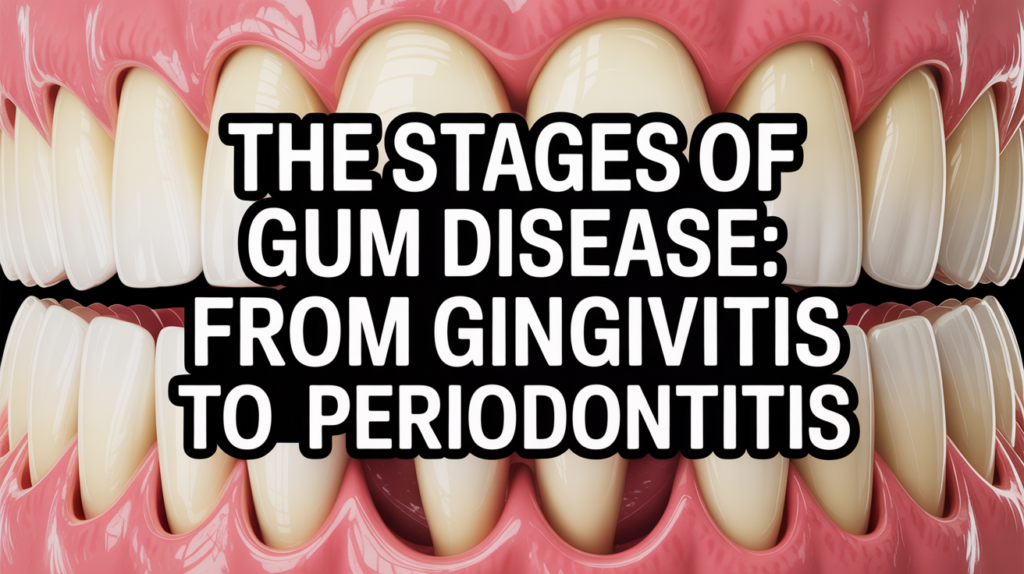The Stages of Gum Disease: From Gingivitis to Periodontitis
Introduction
Gum disease is one of the most common oral health issues, affecting millions of people worldwide. It starts subtly but can lead to serious consequences if left untreated. Understanding its progression-from mild gingivitis to advanced periodontitis-is essential for protecting your teeth and overall health. 😊 This article will guide you through the stages of gum disease, explaining what happens at each phase, how to spot symptoms, and what treatments are available.
We’ll also cover prevention tips, risk factors, and address frequently asked questions about gum disease. By the end, you’ll have a clear roadmap for maintaining healthy gums and knowing when to seek professional help. Let’s dive in and explore how small steps can make a big difference in your oral health journey. 🚀
What Is Gum Disease?
Gum disease, also known as periodontal disease, is an infection of the tissues that hold your teeth in place. It’s caused by plaque-a sticky film of bacteria that forms on teeth. If not removed through proper brushing and flossing, this plaque hardens into tartar, leading to inflammation and infection. Over time, gum disease can damage gums, bone, and even result in tooth loss if untreated. 🦷
Unfortunately, gum disease is incredibly common. Studies show that nearly half of adults over 30 have some form of it. Early detection is critical because catching gum disease early means it’s easier-and often less expensive-to treat. Beyond oral health, gum disease has been linked to other conditions like heart disease and diabetes, making it even more important to stay vigilant. 🔍
Stage 1: Gingivitis-Causes, Symptoms, and Early Intervention
Gingivitis is the first stage of gum disease and, thankfully, the most reversible. It occurs when plaque builds up along the gumline, causing irritation and inflammation. The good news? At this stage, no permanent damage has occurred yet. Common symptoms include red, swollen gums that may bleed easily during brushing or flossing. 😬 While these signs might seem minor, they’re your body’s way of signaling trouble ahead.
If you notice any of these symptoms, don’t panic! Gingivitis can usually be reversed with improved oral hygiene habits. Brushing twice daily, flossing regularly, and scheduling professional cleanings can help eliminate plaque buildup. Think of gingivitis as a wake-up call-it’s your chance to take action before things get worse. ⏰
Remember, consistency is key. Even if your gums feel better after a few days of extra care, keep up the routine. Without ongoing attention, gingivitis can quickly progress to something more serious. By addressing it now, you’re setting yourself up for healthier gums in the long run. 🌱
Stage 2: Early Periodontitis-When Gum Disease Progresses
When gingivitis isn’t treated promptly, it can advance to early periodontitis. At this stage, bacterial toxins begin attacking the bone and connective tissue supporting your teeth. Your immune system tries to fight back, but this battle leads to gum recession and the formation of periodontal pockets-spaces between the gums and teeth where bacteria thrive. 🦠
“Gingivitis is the earliest stage of gum disease. Plaque builds up on your teeth. This plaque contains bacteria that irritate your gums.” -Premier Dental Care
Symptoms become more noticeable here. You might experience persistent bad breath, increased sensitivity, or see your gums pulling away from your teeth. These changes aren’t just cosmetic; they indicate deeper problems brewing beneath the surface. Unfortunately, once you reach this stage, the damage becomes harder to reverse. 😕
Early periodontitis serves as a critical turning point. If you suspect you’re experiencing these symptoms, it’s time to consult a dentist. Professional intervention can stop further damage and preserve your smile. Acting quickly can save you from more invasive treatments down the road. 🛣️
Stage 3: Moderate and Advanced Periodontitis-Damage and Risks
Moderate and advanced periodontitis represent severe stages of gum disease. Here, the infection spreads deeply, destroying more bone and soft tissue. Pockets deepen, teeth loosen, and painful abscesses may form. In extreme cases, patients face significant tooth loss, which can drastically impact their quality of life. 😢
“As the gums become more inflamed, they start to pull away from the teeth, forming spaces known as periodontal ‘pockets.'” -Dental Associates of Marlborough
Pain while chewing, pus discharge, and shifting teeth are hallmark signs of these advanced stages. Treatment options shift toward more aggressive measures like scaling and root planing (deep cleaning), antibiotics, or even surgery. The goal is to halt the disease’s progression and manage symptoms effectively. 💉
While treatment can still help at this stage, outcomes depend heavily on how much damage has already occurred. Prevention truly is the best medicine. Staying proactive about oral health can help you avoid reaching this challenging phase altogether. 🙌
Key Symptoms to Watch For at Each Stage
Recognizing gum disease symptoms early can prevent major complications later on. In the gingivitis stage, look out for bleeding gums, redness, and swelling. As the disease progresses to early periodontitis, symptoms expand to include gum recession and persistent bad breath. 🧐
“Moderate periodontitis… More supporting bone is lost, teeth loosen, and the gums recede further.” -Dental Associates of Marlborough
In moderate to advanced stages, watch for loose teeth, pus around the gums, and deep pockets forming near the base of teeth. Any of these signs warrant immediate dental attention. Remember, catching gum disease early gives you the best shot at successful treatment. Stay alert-it could save your smile! 🦷✨
Comparing Healthy Gums vs. Gum Disease
Healthy gums are firm, pink, and snug against your teeth. They don’t bleed during brushing or flossing and rarely cause discomfort. When gums are healthy, they provide strong support for your teeth, ensuring a confident smile. 😊
In contrast, diseased gums appear red, swollen, and may recede, exposing more of the tooth. They bleed easily, harbor harmful bacteria, and eventually lose their ability to anchor teeth securely. Spotting these differences early can help you take control of your oral health. 🎯
“Advanced periodontitis is the most severe stage… significant damage has occurred to the bone and tissues supporting your teeth.” -The Mugford Center
Risk Factors That Accelerate Gum Disease Progression
Certain factors increase your risk of developing gum disease. Poor oral hygiene tops the list, but smoking, genetics, and chronic illnesses like diabetes also play a role. Medications that reduce saliva flow can leave your mouth vulnerable, while aging naturally weakens gum resilience. ⚖️
Understanding these risks empowers you to take preventive action. For example, quitting smoking or managing diabetes can significantly lower your chances of progressing to advanced stages of gum disease. Knowledge is power-use it to protect your smile! 🛡️
Diagnosis and When to See a Dentist
Dentists diagnose gum disease through visual exams and measuring pocket depths using a special tool called a periodontal probe. Deeper pockets signal advancing disease. Regular check-ups allow dentists to catch problems early before they worsen. 👩⚕️
“There’s no set timeline for gingivitis to progress into periodontitis; it varies between individuals. Factors like your immune system …” -Premier Dental Care
If you notice symptoms like bleeding gums, bad breath, or loose teeth, schedule an appointment right away. Don’t wait until symptoms escalate-early intervention makes all the difference. Prioritize your oral health, and your future self will thank you! 🌟
Available Treatments for Each Stage
Treatment for gingivitis focuses on removing plaque and improving oral hygiene. Professional cleanings paired with consistent home care can restore gum health. For early periodONTITIS, scaling and root planing (deep cleaning) remove built-up tartar and smooth tooth roots to discourage bacteria. 🪥
In moderate to advanced stages, additional treatments like antibiotics or surgical procedures may be necessary. Gum grafts or bone regeneration surgeries aim to repair damaged structures. Your dentist will tailor a treatment plan based on your unique needs. 🧬
“For more advanced stages of gum disease (periodontitis), additional treatments may be necessary. These may include: Scaling and root planing (deep cleaning): This procedure removes plaque and tartar buildup from below the gum line. Antibiotics… Surgery…” -The Mugford Center
No matter the stage, following your dentist’s advice is crucial. Consistent post-treatment care ensures lasting results and minimizes the risk of recurrence. Take charge of your oral health today! 💪
Prevention: Best Practices for Healthy Gums
Preventing gum disease starts with simple yet effective habits. Brush your teeth twice daily, floss every day, and visit your dentist for regular cleanings. Avoid tobacco products, eat a balanced diet rich in vitamins, and drink plenty of water to maintain saliva flow. 🥗💧
By adopting these practices, you create a strong foundation for lifelong oral health. Prevention is always easier than cure-so start now to enjoy a bright, healthy smile for years to come. 🌞
The Link Between Gum Disease and Overall Health
Research shows a strong connection between gum disease and systemic health issues like cardiovascular disease, diabetes, and pregnancy complications. Chronic inflammation from gum disease can affect the entire body, underscoring the importance of oral care. ❤️🩺
Taking care of your gums isn’t just about your smile-it’s about your whole-body wellness. Prioritizing oral health benefits both your mouth and your overall well-being. Make it a priority today! 🌈
Frequently Asked Questions About Gum Disease Stages
What is the first sign of gum disease?
The first sign of gum disease is often bleeding gums, especially during brushing or flossing. Redness and swelling may accompany this symptom. Catching these early signs allows for timely intervention. 🔍
Is gum disease reversible?
Yes, gingivitis-the earliest stage-is reversible with proper care. However, once it progresses to periodontitis, the damage becomes irreversible, though manageable. Early action is key! 🔄
How quickly does gingivitis turn into periodontitis?
The timeline varies depending on individual factors like oral hygiene and genetics. Some people progress rapidly, while others remain stable for years. Consistent care slows progression. ⏳
How is gum disease diagnosed?
Dentists diagnose gum disease through visual exams, probing pocket depths, and assessing gum health. Regular visits ensure early detection. 🪑
What happens if gum disease is left untreated?
Untreated gum disease can lead to tooth loss, painful abscesses, and systemic health risks like heart disease. Seeking treatment early prevents these complications. ⚠️
Conclusion
Understanding the stages of gum disease empowers you to take control of your oral health. From the early warning signs of gingivitis to the severe consequences of advanced periodontitis, knowledge is your greatest ally. Early detection and prompt action can save your smile-and potentially your overall health. 🌟
Call to Action: Maintain good oral hygiene habits, schedule regular dental exams, and seek professional help if you notice symptoms of gum disease. Your gums are worth the effort, and catching problems early ensures a lifetime of healthy smiles. Start today-you’ve got this! 💖



